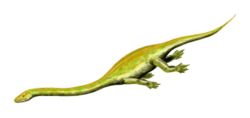- Dinocephalosaurus
-
Dinocephalosaurus
Temporal range: Middle Triassic, 228 Ma
Artist's impression Scientific classification Kingdom: Animalia Phylum: Chordata Class: Reptilia Infraclass: Archosauromorpha Order: Prolacertiformes Family: Tanystrophidae Genus: Dinocephalosaurus
Li, 2003Species - D. orientalis Li, 2003 (type)
Dinocephalosaurus is a genus of long necked, aquatic protorosaur that inhabited the Triassic seas 228 million years ago. Its name means "terrible headed lizard", because the first specimen found was just a skull, discovered near Xinmin in Guizhou Province, China in 2002. The second specimen found was near the same location and contained the head and much of the postcrainal skeleton, minus the tail. Dinocephalosaurus is the "First record of protorosaurid reptile (Order Protorosauria) from the Middle Triassic of China".[1][2]
Contents
Description
Dinocephalosaurus is mostly closely compared with Tanystropheus, both being protorosaurs with necks twice as long as their bodies. While Tanystropheus's neck was composed of twelve elongated cervical vertebrae, Dinocephalosaurus's is from the addition of cervical vertebrae with a minimum of 25, giving the neck a length of ~1.7 m compared to a body length of about 1 m. The necks of both taxa are thought to have evolved convergently from each other. The use of the long neck in Tanystropheus is not fully understood, but it was used for prey capture in Dinocephalosaurus. Dinocephalosaurus differed from all other protorosaurs in the fact that it was the only one that was fully aquatic, but is thought to have laid its eggs on land. Where most protorosaurs had ossified limbs adapted for terrestrial life, dinocephalosaurus "retained juvenile characteristics in the adult stage, as in many other aquatic tetrapods".[3]
Paleobiology
Prey capture
Most scientists who have studied Dinocephalosaurus suggested that it lived in the shallow murky waters of the sea and presumably had a diet of fish and squid. Because of low visibility in the shallow water, the long neck of Dinocephalosaurus would allow it to approach potential prey without them seeing its whole profile. Dinocephalosaurus also had a unique strike capability, where it could increase the volume of its esophagus by flaring out its cervical ribs, creating a vacuum. This is thought to be true because each of the cervical vertebrae had very pronounced transverse processes for muscle attachment and all of the cervical ribs articulated near the anterior end of the cervical vertebrae. This action would also prevent the Dinocephalosaurus from creating a pressure wave alerting the fish that they were being attacked. The Dinocephalosaurus could then grab its prey and hold onto it with the fangs in its upper and lower jaw. This reptile was then thought to have swallowed its prey whole.
An alternate hypothesis was proposed in 2005 by David Peters and colleagues. They noted that several related forms without aquatic adaptations have similar cervical ribs, which provide a passive support system for the elongated neck. Peters and colleagues argued that Dinocephalosaurus captured prey by settling in murky shallows, swiftly lifting its head and neck to strike at fish passing overhead. They concluded that Dinocephalosaurus was a poor swimmer at best, pointing to its extremely wide and flattened torso, skull with eyes on top of its head, and upward-curving snout as indicators of a lie-in-wait style of prey capture.[4]
Classification
Dinocephalosaurus is labeled as a protorosaur but this is still an unresolved issue that can only be confirmed through more evidence and research. The current belief is Dinocephalosaurus is related to Tanystropheus because both share similar anatomical features. These features are a narial recess in the skull, elongation of the neck along with how the cervical vertebrae are associated with the cervical ribs.[5] Although outwardly similar to slender-necked Tanystropheus, Dinocephalosaurus shares more similarities throughout its body plan with some of the larger long-necked Macrocnemus specimens. A number of similarities arise from the skull anatomy, which also places Dinocephalosaurus in the protorosaur order, along with Macrocnemus, such as a low and narrow skull with short and narrow postorbital region.[5] The nasals are longer than the frontals and the posterior process of the jugal is reduced and the genus has more than seven cervical vertebrae.[5]
References
- ^ Acta Geologica Sinica, v. 77, n. 4, p. 419-423.
- ^ Li,C., Rieppel, O.,LaBarbera, M.C. (2004) "A Triassic Aquatic Protorosaur with an Extremely Long Neck ", Science 24 September 2004, 305 (5692) p. 1931 DOI: 10.1126/science.1100498
- ^ A Triassic Aquatic Protorosaur with an Extremely Long Neck ", Science 24 September 2004, 305 (5692) p. 1931 DOI: 10.1126/science.1100498
- ^ Peters, D., Demes, B. and Krause, D.W. (2005). "Suction feeding in Triassic Protorosaur?" Science, 308: 1112-1113.
- ^ a b c The Skeletal Anatomy of the Triassic Protorosaur Dinocephalosaurus orientalis Li, from the Middle Triassic of Guizhou Province, Southern China", Journal of Vertebrate Paleontology March 2008, v.28 n. 1, p. 95-110.
External links
Categories:- Prolacertiformes
- Triassic reptiles
- Prehistoric reptiles of Asia
Wikimedia Foundation. 2010.

